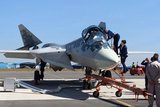Eyes in the sky to defeat terrorist activities
The Defence Science and Technology Laboratory (Dstl), Ministry of Defence scientists, technicians and engineers, has completed a trial which could help disrupt terrorist activities.
The experiment, the first of its kind in the UK, used cutting edge sensors that capture a range of images and data, in support of defence, security and crime prevention.
The trial, at Dstl’s Porton Down site near Salisbury, is designed to assess a range of emerging technologies and understand how they may be used to identify and defeat terrorist networks by tracking insurgents’ movements.
The trial included:
• Airborne, ground-based and vehicle-mounted sensors, both optical and radar
• New data processing techniques
• Two airborne radar sensors that track moving targets from long range
• Electro-optical camera that can identify people in unusual poses, such as holding a weapon
• Wide-area surveillance of static and moving targets
• 3D imagery
• Colour and shape interpretation
Andrew Seedhouse, Sensors and Countermeasures Chief Technologist, Dstl, says: “Think of it as the ultimate CCTV system. An incident occurs, perhaps an IED goes off, and we can use this host of data to back track over time. Who was near the scene and where were they before the incident? What buildings or vehicles can we now associate with the incident?
“Could we now link people, vehicles, events, buildings and locations to the collection of equipment or the buying of materials? All the sensor data can form a complete picture. Looking to the future, this research will help us to look for anomalies both in behaviour and environment, and work towards surveillance alerts to appropriate forces before an incident occurs.”
The aircraft used in the trial, both fixed-wing and helicopters, have been flying from Boscombe Down, over Dstl’s Porton Down site, which is normally restricted airspace.
During the two-week trial, Dstl, industry and university teams gathered up to 40 terabytes of data - the equivalent of 40,000 copies of the Encyclopaedia Britannica. This data will be analysed by industry and the MOD over the coming years as these surveillance techniques are refined. And if quick wins are identified during the analysis then these can be brought forward to the frontline.
The trial was held in collaboration with the Electro Magnetic Remote Sensing Defence Technology Centre (EMRS DTC). Professor Keith Lewis, Research Director of the EMRS DTC, says: “This trial provided an opportunity to quantify the benefits of a number of novel sensing technologies developed as a result of our research programme. Since its inception in 2003, the DTC has been exploring new approaches in remote sensing and has given rise to a number of technologies specifically aimed at enhancing key areas of military requirement.”
The Defence Science and Technology Laboratory is leading research into countering threats by working closely with industry to develop sensing and data management techniques that help defeat the wider insurgent network; this demonstration is a small insight in to that research. The equipment and techniques emerging from this work have the potential to improve safety and security both at home and overseas.
Source: Defence Science and Technology Laboratory
More from Defence Helicopter
-
![Germany to send WS-61 Westland Sea King helicopters to Ukraine]()
Germany to send WS-61 Westland Sea King helicopters to Ukraine
Germany has committed to sending Ukraine six of its 21 retiring WS-61 Westland Sea King multirole, amphibious helicopters.
-
![Boeing secures $271 million to advance modernisation of US Special Operations' MH-47G Chinook]()
Boeing secures $271 million to advance modernisation of US Special Operations' MH-47G Chinook
Boeing has clinched a major contract modification to further its backing of the US Special Operations Command’s MH-47G Chinook aircraft modernisation effort.
-
![Dubai Airshow 2023: South Korean homegrown helicopters make international debut]()
Dubai Airshow 2023: South Korean homegrown helicopters make international debut
Two KAI helicopters, the KUH-1E utility helicopter and the Light Attack Helicopter (LAH), have taken centre stage at the Dubai Airshow 2023.
-
![Italian Navy receives final NH90 helicopter]()
Italian Navy receives final NH90 helicopter
The Italian Navy now boasts a fleet of 56 NH90 helicopters comprising 46 SH-90As and 10 MH-90As.
-
![Argentina seeks AW109 and CH-46 Sea Knight helicopters]()
Argentina seeks AW109 and CH-46 Sea Knight helicopters
The Argentinian Air Force (FAA) and the Argentinian Naval Aviation Command (COAN) are looking for options to upgrade their helicopter fleets.
-
![DSEI 2023: Lockheed to produce about 40% of Black Hawks on UK soil if it wins NMH contest]()
DSEI 2023: Lockheed to produce about 40% of Black Hawks on UK soil if it wins NMH contest
Lockheed Martin promises a boost to the British job market and export opportunities, while strengthening ties with Poland and positioning the UK for a future in rotorcraft technology in the event of a New Medium Helicopter competition triumph.

























